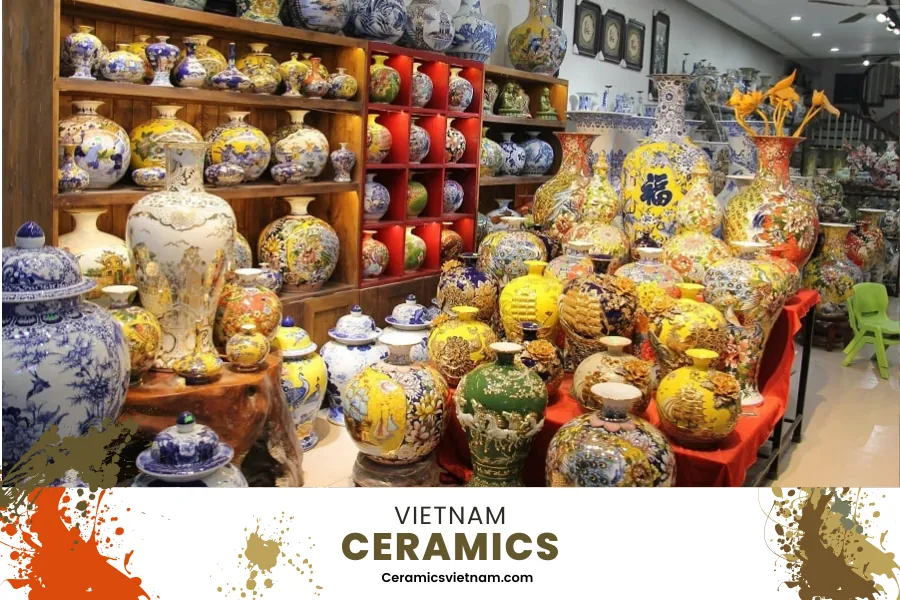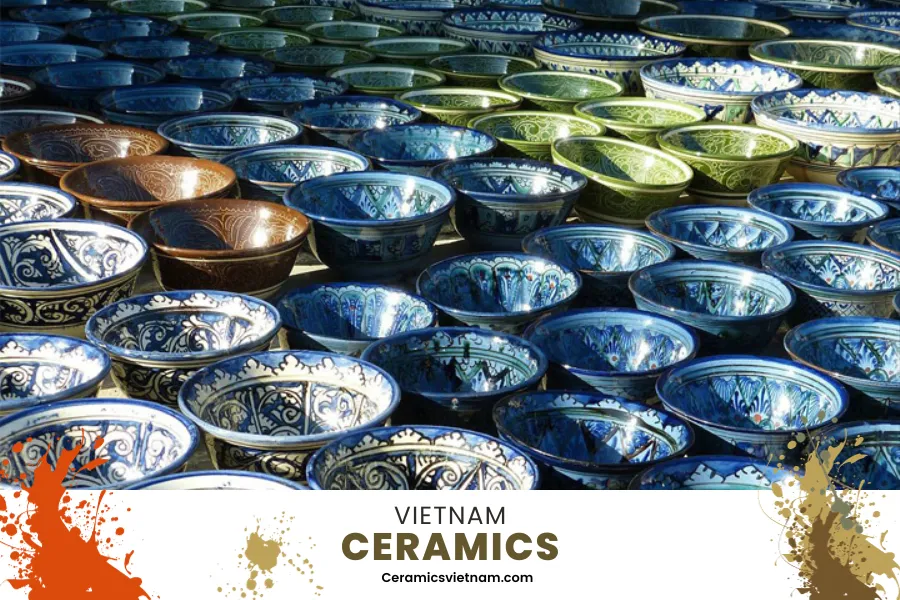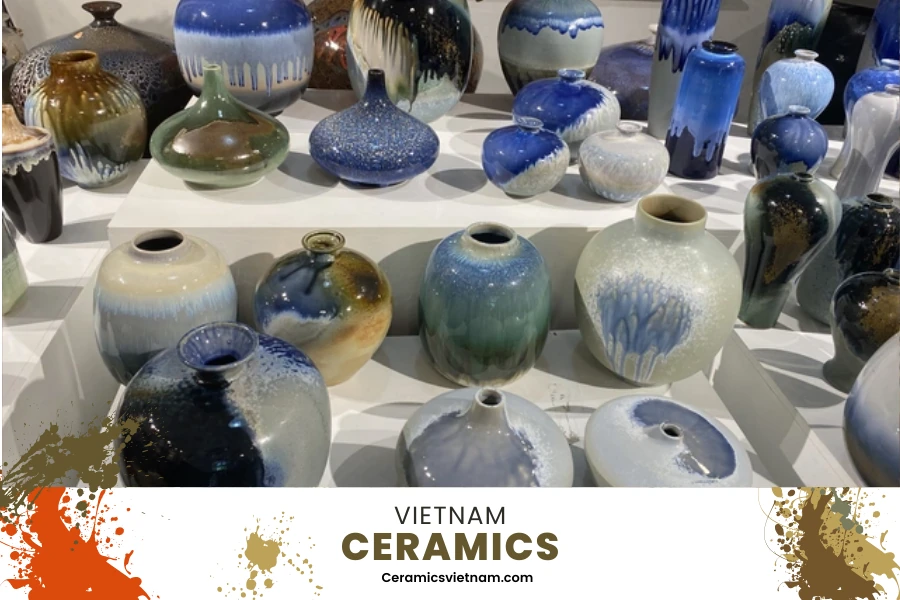Chinese pottery encompasses a wide range of exquisite and high-quality products, especially in the high-end market. However, there is still a prevalent presence of low-quality Chinese pottery with decal prints in the market, featuring diverse designs, attractive colors, and very affordable prices. This situation poses significant challenges for consumers in distinguishing between high-quality Bat Trang pottery and the low-quality Chinese pottery. Below, we will provide some criteria to help you easily identify authentic Bat Trang pottery.
Bat Trang pottery village

Distinguishing between Bat Trang ceramic and Chinese ceramic
Bat Trang pottery village, situated on the banks of the Red River in northern Vietnam, holds a rich and storied history as a renowned center for traditional ceramic craftsmanship. With origins dating back over 500 years, this ancient village has been a hub for producing exquisite ceramics that reflect the skill, artistry, and cultural heritage of Vietnam.
Renowned for its unique blend of tradition and innovation, Bat Trang has earned a reputation as one of the most famous pottery villages in Southeast Asia. The village has seamlessly integrated age-old techniques with contemporary designs, attracting both domestic and international admiration for its diverse and high-quality ceramic products.
The skilled artisans of Bat Trang, often following family traditions passed down through generations, create a wide array of items, including intricately hand-painted bowls, vases, plates, and figurines. Each piece bears the distinctive touch of the craftsmen, showcasing the village’s commitment to preserving traditional Vietnamese ceramic art.
Beyond its artistic significance, Bat Trang pottery plays a crucial role in preserving cultural heritage. The village has become a cultural destination, welcoming visitors to witness the pottery-making process, engage with artisans, and explore the historical aspects of this craft. The lively atmosphere of the village, coupled with its vibrant marketplaces, provides a unique opportunity for individuals to immerse themselves in the world of Bat Trang pottery.
As Bat Trang continues to evolve, it remains a testament to the resilience of traditional craftsmanship in the face of modernization. With its intricate designs, commitment to quality, and a legacy rooted in centuries of tradition, Bat Trang pottery village stands as a symbol of Vietnam’s rich cultural heritage and artistic prowess.
What are the ways to distinguish between Bat Trang pottery and Chinese pottery?

Distinguishing between Bat Trang ceramic and Chinese ceramic
To differentiate between Bat Trang pottery and Chinese pottery, we need to consider the following five points: patterns on the ceramic products, colors used in those patterns, clay composition, thickness, and overall product quality. A common characteristic of Bat Trang pottery is that it is made from high-quality clay, specifically kaolin clay, whereas the source of clay for Chinese pottery is often unclear. Most Bat Trang pottery products are fired at temperatures exceeding 1200ºC, while Chinese pottery is often fired at lower temperatures, potentially not effectively removing harmful impurities as in Bat Trang pottery.
This difference significantly impacts the color and quality of the products. At a glance, we can observe that Chinese pottery tends to have bold and heavy colors, while Bat Trang pottery exhibits sharp and beautiful colors. Regarding durability, Bat Trang pottery products are often coated with a layer of glaze, protecting colors and patterns, ensuring long-lasting quality over time.
In summary, the use of high-quality clay, high firing temperatures, and protective coatings are distinguishing features of Bat Trang pottery, setting it apart from lower-quality Chinese pottery.
Decoration patterns on Bat Trang pottery and Chinese pottery
An easily recognizable distinction lies in the decal transfer technology used in cheap Chinese pottery. It often involves using decals to imprint patterns, followed by placing the product in a steaming kiln where the ink from the decal adheres to the ceramic surface. The characteristic of this decal printing is that the lines are usually very uniform, lacking distinct shades, and sometimes the patterns may appear faded and coarse.
In contrast to Chinese pottery with decal printing, patterns on Bat Trang pottery are meticulously hand-painted, resulting in varying shades, delicacy, and a unique softness for each pattern. Even within a set of identical vases, the patterns on two items may differ – for example, one may have larger or finer details than the other. A notable feature in Bat Trang pottery is the glazing step, a process absent in Chinese pottery with decal printing.
In this step, after the product undergoes high-temperature firing in the kiln, a thin layer of glaze is applied to hand-painted patterns, providing everlasting protection over time. This can be considered a significant difference and a major advantage of Bat Trang pottery over Chinese pottery.
Therefore, when selecting ceramic items, pay attention to the finely detailed hand-painted patterns to accurately differentiate between authentic and counterfeit products.
The color of the main decorative patterns on Bat Trang pottery and Chinese pottery
With the advancements in ceramic technology today, both Bat Trang ceramic and Chinese ceramic offer products in various vibrant colors such as red, yellow, and green. However, the significant difference lies in the ink used for the ceramic patterns. Due to the decal printing method, the ink on Chinese pottery tends to be bold and intense. Without the protective glaze layer found in Bat Trang pottery, this ink color may fade over time due to washing or cleaning the product.
On the other hand, in Bat Trang pottery, the ceramic glaze layer serves to protect the colors of the hand-painted patterns. Although the colors may be slightly fainter than those in decal printing, they still retain a distinct contrast between light and dark shades, maintaining the delicacy and softness of the patterns. Importantly, these colors do not fade over time, even with thorough cleaning, ensuring that Bat Trang pottery products remain vibrant and as new over the years.
The clay composition determines the quality of Bat Trang pottery and Chinese pottery
What is clay composition? It is a term used by ceramic artisans in the trade, referring to the tight bonding between elements within the clay that forms the ceramic product. In high-quality Bat Trang pottery products, when the clay composition is of high quality and fired at high temperatures, the resulting ceramic will exhibit a bright white glaze, often described in traditional terms as “as white as peeled chicken eggs.”
On the other hand, Chinese pottery products may have a more opaque, ivory-colored glaze and lack the same brilliance. However, in contemporary times, some Bat Trang pottery products may use lower-quality clay to reduce production costs, resulting in products that do not achieve the same bright white appearance as traditional high-quality Bat Trang pottery. Therefore, distinguishing between Bat Trang pottery and Chinese pottery based on this criterion can be challenging.
However, there is a practical method to assess the clay composition of pottery during use. Bat Trang pottery, due to its high-quality clay, can withstand heat well, making it suitable for use in microwaves. In contrast, Chinese pottery may be more prone to cracking or fissures, especially around the mouth, when exposed to heat.
The thickness difference between Bat Trang pottery and Chinese pottery
Bat Trang pottery is crafted manually, resulting in a greater thickness compared to Chinese products. When you hold a Bat Trang pottery item, you’ll experience a solid and sturdy feel in your hands.
This characteristic is a result of the meticulous handcrafting process employed in Bat Trang, where artisans pay careful attention to the thickness of the ceramic walls. The handmade nature of Bat Trang pottery allows for a tactile sense of robustness, offering a substantial and well-crafted feel when handled.
On the other hand, Chinese pottery, often produced through more mechanized processes, may exhibit a thinner and less substantial feel. The mass production methods can sometimes compromise the overall thickness of the ceramic, affecting the tactile experience when holding these items.
Quality comparison between Bat Trang pottery and Chinese pottery
Due to being crafted manually, Bat Trang pottery products are consistently protected by an outer glaze layer. This glazing ensures that the decorative patterns remain vibrant, sharp, and well-defined over time. Additionally, it guarantees the safety of the users by preventing any potential contact with harmful substances.
In contrast, Chinese pottery is prone to pattern fading and blurring, especially with prolonged use. The patterns on Chinese pottery may lose their vibrancy more quickly. Moreover, the ink used in printing on Chinese pottery often contains lead, posing potential health risks to consumers.
With these distinctions, it becomes evident that Bat Trang pottery prioritizes both aesthetic longevity and user safety. The protective glaze not only preserves the visual appeal of the patterns but also serves as a health-conscious choice for consumers.
By understanding the five differentiation methods outlined above, consumers can equip themselves with fundamental knowledge when purchasing ceramic items. This knowledge empowers individuals to make informed decisions, ensuring they choose high-quality Bat Trang pottery over potentially inferior Chinese pottery.

Distinguishing between Bat Trang ceramic and Chinese ceramic














Leave a reply